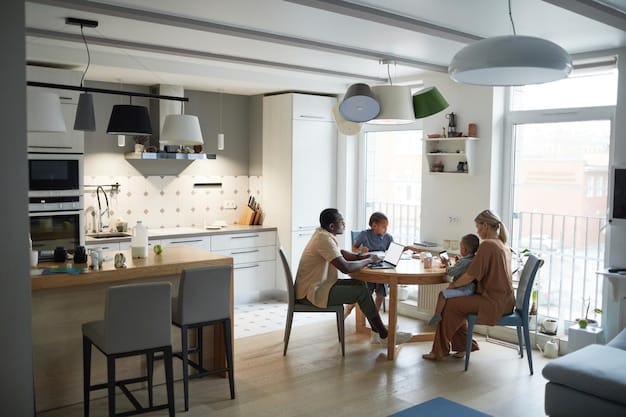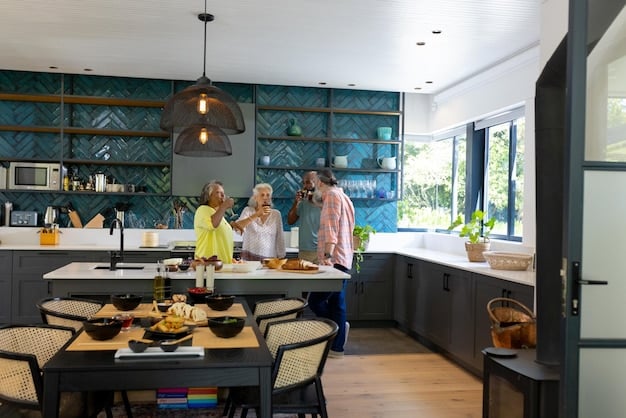Co-Living in the US: Is It the Future of Housing?

The Future of Co-Living: Is It Right for You in the US Housing Market? focuses on the rising trend of co-living spaces in the United States, examining its potential as a viable housing option, especially for those seeking community, affordability, and flexibility amidst the evolving housing landscape.
Is co-living the answer to the US housing crunch? This article examines the future of co-living in the US housing market, exploring whether this communal lifestyle is a good fit for you.
Understanding the Co-Living Concept
Co-living is emerging as a popular housing alternative, especially among young professionals and those seeking community. But what exactly is it, and how does it differ from traditional apartment living?
Essentially, co-living combines private living spaces with shared communal areas. These shared spaces can include kitchens, living rooms, workspaces, and even recreational facilities. The aim is to foster a sense of community and collaboration among residents.

Key Features of Co-Living Spaces
Co-living spaces come with unique perks, but can be slightly different depending on the exact space in question. Here are some of the most common:
- All-inclusive rent: Utilities, internet, and sometimes even housekeeping are included in the monthly rent, simplifying budgeting.
- Community focus: Organized events and shared spaces encourage residents to interact and form connections.
- Flexibility: Many co-living spaces offer flexible lease terms, catering to those who may not be ready for a long-term commitment.
- Shared amenities: Access to shared amenities like gyms, laundry facilities, and entertainment areas can enhance the living experience.
Co-living isn’t just about sharing space; it’s about sharing experiences and building relationships. The design of co-living spaces promotes interaction and collaboration, making it an attractive option for those seeking a sense of belonging.
The Rise of Co-Living in the US Market
The demand for co-living is on the rise in the US, driven by several factors. Understanding these factors can help you determine if co-living is a suitable option for your housing needs.
Urbanization, rising housing costs, and a desire for community are all contributing to the growing popularity of co-living spaces. As cities become more crowded and expensive, people are seeking more affordable and convenient housing solutions.

Factors Driving the Co-Living Trend
Several factors are behind the growing popularity of co-living. Here are some of those factors:
- Affordability: Co-living can be more affordable than renting a traditional apartment, especially in expensive urban areas.
- Community: Many people are drawn to co-living for the sense of community and social connection it provides.
- Convenience: All-inclusive rent and shared amenities make co-living a hassle-free housing option.
- Flexibility: Flexible lease terms cater to the needs of young professionals and those who may not want a long-term commitment.
Co-living is particularly appealing to millennials and Gen Z, who value experiences and community over material possessions. These generations are more likely to embrace shared living spaces and the opportunities for social interaction they provide.
Benefits of Choosing Co-Living
There are numerous advantages to opting for co-living over traditional rental options. By understanding these benefits, you can assess whether co-living aligns with your lifestyle and priorities.
From affordability and convenience to community and networking opportunities, co-living offers a range of benefits that can enhance your quality of life. It’s more than just a place to live; it’s a lifestyle choice.
Financial and Social Advantages
Co-living brings both financial and social benefits. Here are some of the most important ones:
- Cost Savings: Sharing resources reduces individual expenses, leading to significant cost savings.
- Networking: Living with diverse individuals expands your professional and social network.
- Reduced Responsibility: Shared responsibilities alleviate the burden of maintaining a home.
- Instant Community: Built-in social interactions combat loneliness and foster a sense of belonging.
Potential Drawbacks to Consider
While co-living offers many benefits, it’s important to acknowledge the potential drawbacks as well. Understanding these challenges can help you make an informed decision about whether co-living is the right choice for you.
Lack of privacy, shared responsibilities, and potential conflicts with housemates are some of the challenges that co-living residents may face. It’s essential to weigh these factors against the benefits before committing to this lifestyle.
Navigating Co-Living Challenges
Co-living is not perfect, and comes with its challenges.
One of the most common challenges is the potential for conflicts with housemates. Clear communication, mutual respect, and a willingness to compromise are essential for resolving disagreements and maintaining a harmonious living environment.
Another challenge is the lack of privacy. While co-living spaces offer private bedrooms, the shared living areas can feel crowded at times, especially during peak hours. It’s important to establish personal boundaries and find ways to create private space when needed.
Is Co-Living Right for You? Factors to Consider
Determining whether co-living is the right choice for you involves considering your personality, preferences, and lifestyle. Assessing these factors can help you decide if this communal living arrangement aligns with your needs and expectations.
Are you comfortable sharing space with others? Do you value community and social interaction? Are you willing to compromise and respect the needs of your housemates? These are some of the questions you should ask yourself before making the decision to move into a co-living space.
Questions to Ask Yourself
Here are some more questions you might want to ask:
- What are your personal boundaries? Be honest with yourself of what you are not willing to compromise on.
- What are your deal breakers? Noise? Messiness? Smoking?
- What is your budget? Make sure you can afford the monthly rent and other expenses associated with co-living.
- What are your expectations? Be clear about what you hope to gain from the co-living experience.
Ultimately, the decision of whether to embrace co-living depends on your individual circumstances and preferences. Weigh the benefits against the drawbacks and consider whether this lifestyle aligns with your values and goals.
The Future of Co-Living Trends and Predictions
The co-living industry is evolving rapidly, with new trends and innovations emerging all the time. Understanding these trends can help you anticipate the future of co-living and make informed decisions about your housing options.
Sustainability, wellness, and technology are some of the key trends shaping the future of co-living. As people become more environmentally conscious and health-focused, co-living spaces are incorporating sustainable practices and wellness amenities to meet their changing needs.
Sustainability and Design
Looking ahead to the future, these aspects of co-living are key:
One of the key trends is the integration of smart home technology. From smart thermostats and lighting systems to automated security and access control, technology is enhancing the convenience and efficiency of co-living spaces.
Another trend is the focus on sustainability. Co-living developers are incorporating eco-friendly materials, energy-efficient appliances, and waste reduction programs to minimize their environmental impact. This is attracting environmentally conscious residents who are looking for sustainable housing options.
| Key Point | Brief Description |
|---|---|
| 🏡 Definition of Co-living | Combines private rooms with shared communal spaces. |
| 📈 US Market Growth | Driven by urbanization, high costs, and desire for community. |
| ✅ Benefits of Co-living | Affordability, convenience, community, and opportunities for networking. |
| 🤔 Is it Right for You? | Consider lifestyle, preferences, and comfort sharing spaces. |
Frequently Asked Questions (FAQ)
▼
Co-living spaces typically attract young professionals, entrepreneurs, digital nomads, and those seeking a strong sense of community. Age ranges vary, but many residents are in their 20s and 30s.
▼
Pet policies vary depending on the specific co-living space. Some facilities welcome pets, while others have restrictions on the type, size, or number of animals allowed. It’s best to check with the individual co-living provider.
▼
Most co-living spaces have community managers or mediators who are trained to resolve conflicts. Open communication and a willingness to compromise are essential for maintaining a harmonious living environment.
▼
Social events can range from casual gatherings and potlucks to organized workshops, movie nights, and outings. The goal is to foster a sense of community and provide opportunities for residents to connect with one another.
▼
Co-living typically offers more structured community events, all-inclusive rent, and shared amenities compared to traditional shared apartments. It’s designed to facilitate a more intentional and social living experience.
Conclusion
In conclusion, the future of co-living in the US housing market presents a compelling option for those seeking affordability, community, and flexibility. While it may not be for everyone, understanding the benefits and potential downsides can help you make an informed decision about whether co-living is the right fit for your unique needs and lifestyle.





